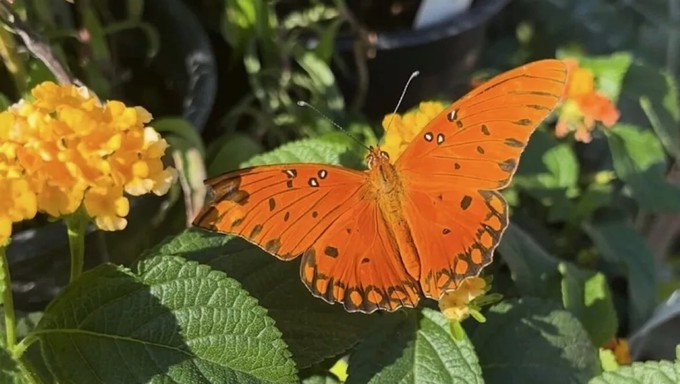
The Secret Garden celebrates with two weekends of family fun

The beautiful Gulf Fritillary butterfly is the focus of The Secret Garden's Butterfly Fest, Sept. 14-15 and 21-22. Courtesy The Secret Garden
Love butterflies? It’s time to wing it to The Secret Garden in Elk Grove.
The butterflies – specifically Gulf Fritillary butterflies – annually return to this destination nursery during their migration, attracted by their favorite host plant: passionflower.
Each September, The Secret Garden celebrates their comeback with its annual “Butterfly Fest.” And after the large crowd that turned out last year, The Secret Garden decided to double the celebration with two weekends devoted to butterfly fun.
On Sept. 14-15 and Sept. 21-22, Butterfly Fest will entertain and inform about these important and beautiful pollinators. Hours are 10 a.m. to 2 p.m. each day; admission is free.
“Mark your calendars for a fluttering good time at The Secret Garden's Annual Butterfly Fest this September!” say the organizers. “Due to last year's incredible turnout, we're excited to announce an extended celebration over two weekends.
“Immerse yourself in the enchanting world of butterflies and pollinators at our local nursery. Every year, The Secret Garden becomes a haven for Gulf Fritillary butterflies during their migration, attracted to our lush passionvine. Join us as we honor these winged wonders and delve into the importance of pollinators in our ecosystem.”
At 11 a.m each day, take a guided tour of the butterfly’s life cycle with a visit to see hungry caterpillars in action as well as mature butterflies.
Designed for the whole family, the fest offers free kid activities such as face painting. A coffee cart will offer beverages. Or visitors can enjoy a scoop of Leatherby’s ice cream.
To coax more butterflies to your landscape, take home some perennials including such butterfly favorites as California native milkweed and passionflower. (They’ll be on sale for 15% off.)
Butterflies are most active in the cooler morning hours, so get there early to enjoy the show.
The Secret Garden is located at 8450 W. Stockton Blvd., Elk Grove.
For details and directions: https://www.secretgarden-online.com/.
Comments
0 comments have been posted.Sacramento Digs Gardening to your inbox.
Food in My Back Yard Series
May 6: Maintain soil moisture with mulch for garden success
April 29: What's (already) wrong with my tomato plants?
April 22: Should you stock up on fertilizer? (Yes!)
April 15: Grow culinary herbs in containers
April 8: When to plant summer vegetables
April 1: Don't be fooled by these garden myths
March 25: Fertilizer tips: How to 'feed' your vegetables for healthy growth
March 18: Time to give vegetable seedlings some more space
March 11: Ways to win the fight against weeds
March 4: Potatoes from the garden
Feb. 25: Plant a fruit tree now -- for later
Feb. 18: How to squeeze more food into less space
Feb. 11: When to plant? Consider staggering your transplants
Feb. 4: Starting in seed starting
Sites We Like
Garden Checklist for week of May 4
Enjoy this spring weather – and get gardening!
* Plant, plant, plant! It’s prime planting season in the Sacramento area. Time to set out those tomato transplants along with peppers and eggplants. Pinch off any flowers on new transplants to make them concentrate on establishing roots instead of setting premature fruit.
* Direct-seed melons, cucumbers, summer squash, corn, radishes, pumpkins and annual herbs such as basil.
* Harvest cabbage, lettuce, peas and green onions.
* In the flower garden, direct-seed sunflowers, cosmos, salvia, zinnias, marigolds, celosia and asters. (You also can transplant seedlings for many of the same flowers.)
* Plant dahlia tubers. Other perennials to set out include verbena, coreopsis, coneflower and astilbe.
* Transplant petunias, marigolds and perennial flowers such as astilbe, columbine, coneflowers, coreopsis, dahlias, rudbeckia and verbena.
* Keep an eye out for slugs, snails, earwigs and aphids that want to dine on tender new growth.
* Feed summer bloomers with a balanced fertilizer.
* For continued bloom, cut off spent flowers on roses as well as other flowering plants.
* Add mulch to the garden to maintain moisture. Mulch also cuts down on weeds. But don’t let it mound around the stems or trunks of trees or shrubs. Leave about a 6-inch to 1-foot circle to avoid crown rot or other problems.